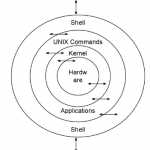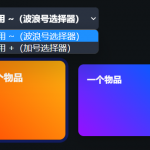Breath First Search是一种用于图数据结构的图遍历技术。它逐级进行。图是树状的数据结构。为了避免在遍历图的过程中访问节点,我们使用BFS。
在这个算法中,假设我们从节点 x 开始,然后我们将访问 x 的邻居,然后访问 x 的邻居的邻居,依此类推。
算法
为了使用BFS遍历图,我们使用队列来存储节点和数组数据结构来区分未访问的节点。
- 1 . 创建空队列并将未访问的顶点推送到它。
- 2 . 除非队列为空,否则请执行以下操作。
- 2.1从队列中弹出元素
- 2.2将弹出节点的未访问的相邻节点推入队列。
考虑这张图

根据我们的算法

因此访问了所有顶点,然后执行唯一的弹出操作,然后队列将为空。
#include <bits/stdc++.h>
using namespace std;
void connect_edges(list<int>,int ,int );
void BFS(list<int>*,int);
void connect_edges(list<int> *lst,int X,int Y){
//for the undirected graph we have to make a link of X-->Y and Y-->X
lst[X].push_back(Y);
lst[Y].push_back(X);
return;
}
void BFS(list<int>*lst,int count,int X){
//created a boolean array to find out the unvisited nodes
bool *visited= new bool[count];
for(int i=0;i<count;i++){
visited[i]=false;
}
queue<int> q;
q.push(X);
while(!q.empty()){
int ele=q.front();
q.pop();
//take one element from the queue and check the element is
//unvisited or not
if(!visited[ele]){
visited[ele]=true;
//print the unvisited nodes
cout<<ele<<" ";
list<int>::iterator it;
for(it=lst[ele].begin();it!=lst[ele].end();it++){
q.push(*it);
}
}
}
}
// Print the Adjacency List
void print(list<int> *lst,int count){
list<int>::iterator it;
for(int i=0;i<count;i++){
cout<<i<<"-->";
for(it=lst[i].begin();it!=lst[i].end();it++){
cout<<*it<<"-->";
}
cout<<endl;
}
}
int main(){
int count;
cout<<"Enter the no. of vertices : ";
cin>>count;
cout<<endl;
list<int> *lst=new list<int>[count];
connect_edges(lst,0,1);
connect_edges(lst,0,2);
connect_edges(lst,2,4);
connect_edges(lst,3,2);
connect_edges(lst,4,5);
connect_edges(lst,3,5);
connect_edges(lst,1,3);
connect_edges(lst,5,0);
cout<<"Adjacency matrix: "<<endl;
print(lst,count);
cout<<"BFS : "<<endl;
BFS(lst,count,0);
return 0;
}
输出:
Adjacency matrix: 0–>1–>2–>5 1–>0–>3 2–>0–>4–>3 3–>2–>5–>1 4–>2–>5 5–>4–>3–>0 BFS : 0 1 2 5 3 4
这就是 C++ 中广度优先搜索的全部内容。





